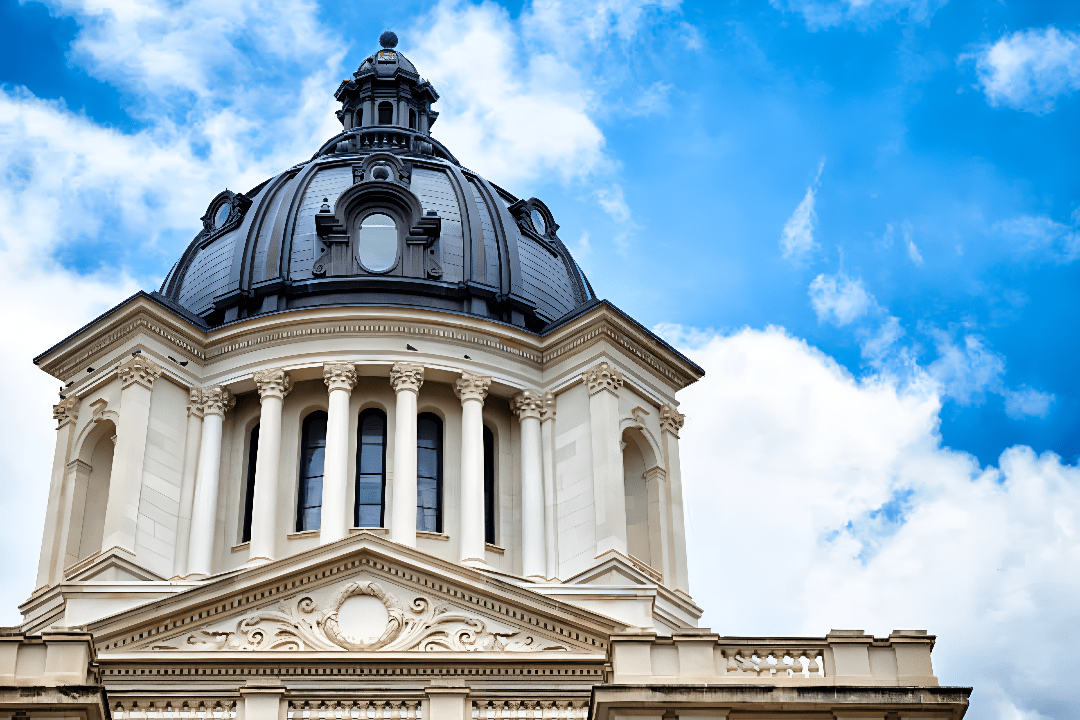Understanding the South Dakota grocery tax is essential for both consumers and businesses. Unlike many states that exempt groceries, South Dakota applies its full sales tax rate of 4.2% to food purchases. Local jurisdictions can add up to 2%, bringing the combined rate as high as 6.2% in cities such as Sioux Falls and Rapid City.
While groceries bought with SNAP or WIC benefits are exempt, most everyday staples, prepared meals, and beverages are fully taxed. For businesses, this means accurate pricing, compliance, and reporting are essential to avoid penalties and audits.
This blog offers a detailed examination of grocery tax rules, local variations, compliance challenges, and how solutions like Commenda can streamline sales tax management.
Does South Dakota Tax Groceries?
The South Dakota grocery tax applies at the same rate as the general state sales tax. As of 2025, groceries are subject to taxation in South Dakota. Instead, food purchases are subject to the statewide rate of 4.2%, and some local jurisdictions add up to 2%, resulting in a combined rate as high as 6.2% in cities such as Sioux Falls, Brookings, and Rapid City. Federal rules provide the only exemption: groceries purchased with SNAP or WIC benefits are exempt from taxation.
For retailers and businesses, the South Dakota grocery tax is more than a compliance requirement. It directly impacts pricing, receipts, and record-keeping. Misclassifying items, such as prepared meals versus grocery staples, or failing to apply the correct combined local rate, can lead to under-collection, penalties, or state audits.
Overview of Sales Tax in South Dakota
The South Dakota sales tax system is straightforward compared to many other states, but leaves little room for exemptions. The state sales tax rate is 4.2%, applying broadly to most tangible goods, many services, groceries, and digital products. In addition to the state rate, local jurisdictions can impose an additional sales tax, ranging from 0% to 2%, which brings the combined rate up to 6.2% in some cities.
Unlike states that exempt groceries or offer reduced rates on essentials, South Dakota taxes food and household staples the same way it taxes consumer electronics or clothing. For example, both a gallon of milk and a smartphone are taxed at the same baseline rate of 4.2%.
Grocery Tax Rules in South Dakota
The grocery tax in South Dakota applies to nearly all food items sold in retail stores. Unlike some states that distinguish between essential groceries and discretionary snack foods, South Dakota does not carve out special exemptions.
- Groceries and staples (milk, bread, fruit, and vegetables) are taxed at 4.2%.
- Prepared foods, such as hot takeout meals or restaurant dishes, are taxed at the same 4.2% rate and may also incur additional municipal gross receipts tax (MGRT).
- Candy, soda, and snack foods are taxed the same as groceries, with no separate classification.
- SNAP/WIC purchases are exempt under federal law. For instance, if a customer uses an EBT card to purchase apples and milk, no sales tax applies.
This approach keeps the South Dakota food tax consistent across product types, but it creates challenges for retailers. The difficulty lies not in different tax rates but in determining whether a product qualifies as a “prepared food”.
Tax on Food and Beverages in South Dakota
Understanding how the tax on food in South Dakota applies to different product categories is crucial for accurate compliance. Here’s a breakdown:
- Grocery staples such as milk, rice, eggs, and apples are taxed at 4.2%.
- Prepared meals and hot food, whether purchased from a restaurant or grocery deli, are taxed at 4.2% plus any applicable municipal gross receipts tax.
- Candy, soda, and snack foods fall under the same category as groceries and are taxed at 4.2%.
- Alcoholic beverages are subject to their own excise tax provisions, in addition to sales tax.
- Coffee beans purchased for home brewing are taxed at 4.2%, while brewed coffee sold as takeout is also taxed at 4.2% plus potential local MGRT.
Unlike states with quirky rules, such as New York’s sliced bagel rule, South Dakota applies a uniform approach. Both food consumed at home and food consumed immediately are taxed at the same state rate, though some municipalities may add their own requirements.
This system means that the sales tax on groceries in South Dakota does not distinguish between staples and discretionary foods. The consistency simplifies the rulebook but increases the financial impact for families and consumers, as essential items are taxed the same as luxury purchases.
Local Jurisdiction Variations in South Dakota
While the statewide sales tax is 4.2%, municipalities can impose additional sales tax. These local jurisdiction variations mean the final grocery bill can differ significantly depending on the city.
| City | State Rate | Local Add-On | Combined Rate | Notes |
| Sioux Falls | 4.2% | 2.0% | 6.2% | Applies to groceries and prepared foods |
| Rapid City | 4.2% | 2.0% | 6.2% | Includes both groceries and restaurants |
| Brookings | 4.2% | 2.0% | 6.2% | Applies equally to most retail goods |
These differences highlight why retailers with multiple locations must carefully apply the correct combined rates. For example, a bag of apples bought in Sioux Falls may carry a total tax rate of 6.2%, while the same item in a rural area without local add-ons would only be taxed at 4.2%.
Examples: How Grocery Tax Applies in South Dakota
The following examples illustrate how the food and beverage tax in South Dakota is applied in practice:
- Bag of apples: Taxed at 4.2% statewide, plus local add-ons.
- Packaged candy: Taxed at 4.2%, plus local add-ons.
- Restaurant meal: Taxed at 4.2% statewide, plus local sales tax and possible MGRT.
- Coffee beans (for home use): Taxed at 4.2% statewide, plus local add-ons.
- Brewed coffee (takeout): Taxed at 4.2% statewide, plus local add-ons and possible MGRT.
- SNAP/WIC purchases: Exempt from tax, regardless of item, as long as they qualify under federal benefit rules.
These scenarios show that groceries, prepared meals, and snack foods all fall under the South Dakota food tax, while the method of purchase, such as SNAP/WIC, can create exemptions.
Compliance Challenges for Businesses in South Dakota
Businesses collecting the South Dakota grocery tax face several compliance challenges:
- Prepared food definitions – Determining whether an item counts as a grocery staple or a prepared meal can be confusing. A preheated sandwich may be classified differently from a packaged sandwich.
- Multi-location compliance – Businesses operating across multiple cities must calculate and apply the correct combined state and local tax rates.
- Reporting requirements – Filing accurate reports with the Department of Revenue requires up-to-date record-keeping. Errors can result in penalties or audits.
- SNAP/WIC exemptions – Tracking exempt transactions requires careful management of point-of-sale systems.
Failing to apply the correct grocery tax in South Dakota not only risks fines but also damages customer trust. Over-collecting tax can lead to customer dissatisfaction, while under-collecting may result in penalties or repayment obligations during audits.
How Commenda Helps with South Dakota Grocery Tax Compliance
For businesses, staying compliant with the South Dakota grocery tax requires precision and constant updates. That’s where Commenda’s Sales Tax Software provides significant value.
- It automates grocery and food tax calculations for each location.
- It updates instantly when state or local rates change, removing the burden of manual monitoring.
- It simplifies tax filings and compliance tracking, ensuring businesses file accurately with the Department of Revenue.
- It reduces compliance risks, prevents over- or under-collection, and saves significant administrative time.
For multi-location retailers, Commenda ensures consistency across jurisdictions, eliminating guesswork and reducing the risk of penalties. By using automation, businesses can focus on operations while remaining fully compliant with the South Dakota food tax rules.
Book a demo today with Commenda to ensure your grocery tax compliance in South Dakota is accurate and effortless.
FAQs on Grocery Tax in South Dakota
1. Are groceries taxed in South Dakota?
Yes. The South Dakota grocery tax applies to nearly all grocery items at the full state sales tax rate of 4.2%. Unlike many states that exempt food essentials, South Dakota treats groceries the same as other taxable goods. Local jurisdictions may add up to 2%, which can increase the combined rate to 6.2% in cities such as Sioux Falls, Rapid City, and Brookings.
2. Is there sales tax on prepared food in South Dakota?
Yes. Prepared food, such as hot meals, deli items, or restaurant takeout, is fully taxable in South Dakota. These purchases are subject to the 4.2% state sales tax, plus additional local sales taxes and, in some areas, a municipal gross receipts tax (MGRT).
3. Are soft drinks and candy taxed?
Yes. In South Dakota, there is no distinction between grocery staples and discretionary items like candy or soda. All are subject to the 4.2% state grocery tax, along with applicable local add-ons. For example, a bottle of soda or a bag of candy is taxed the same way as a gallon of milk.
4. Are groceries purchased with SNAP/WIC taxed?
No. Groceries purchased using SNAP (Supplemental Nutrition Assistance Program) or WIC (Women, Infants, and Children) benefits are exempt from sales tax in South Dakota. This exemption follows federal rules designed to protect low-income households from additional food costs.
5. Do restaurants charge sales tax in South Dakota?
Yes. Meals and beverages purchased at restaurants are taxable. They are subject to the 4.2% state sales tax, plus any applicable local sales tax, and in some municipalities, an extra MGRT surcharge. This means dining out in Sioux Falls or Rapid City often carries a higher combined tax rate than grocery purchases at a supermarket in a smaller town.
6. How often do grocery tax laws change?
South Dakota does not make frequent adjustments to its sales tax laws, but changes can happen at both the state and local level. Statewide sales tax rates may be adjusted during legislative sessions, while municipalities may periodically increase or decrease their local add-ons. Retailers should stay informed through the South Dakota Department of Revenue (dor.sd.gov) to avoid compliance issues.
7. How can businesses automate compliance?
Businesses can automate compliance by implementing tax software that applies the correct statewide grocery tax rate and adjusts for local add-ons automatically. These systems also recognize SNAP/WIC exemptions and help generate accurate reports for filing with the Department of Revenue.
8. Does Commenda’s software handle multi-state grocery tax?
Yes. Commenda’s Sales Tax Software is designed to handle compliance across multiple states, including South Dakota. It updates tax rules automatically whenever state or local rates change, applies the correct tax treatment for groceries, prepared foods, and exemptions, and simplifies reporting. For businesses with multi-state operations, this ensures consistency, prevents errors, and reduces the risk of penalties or audits.










